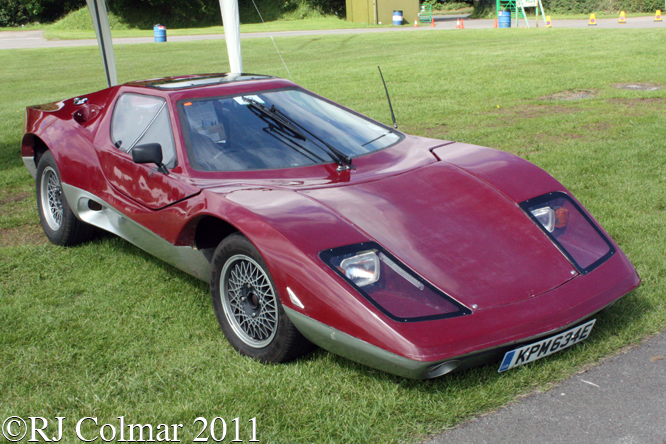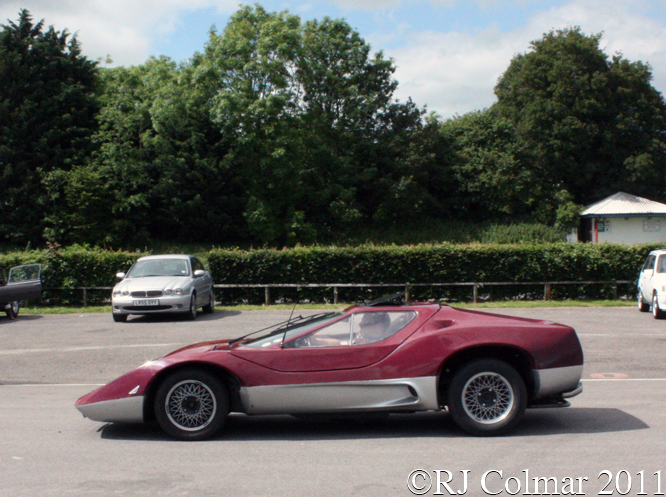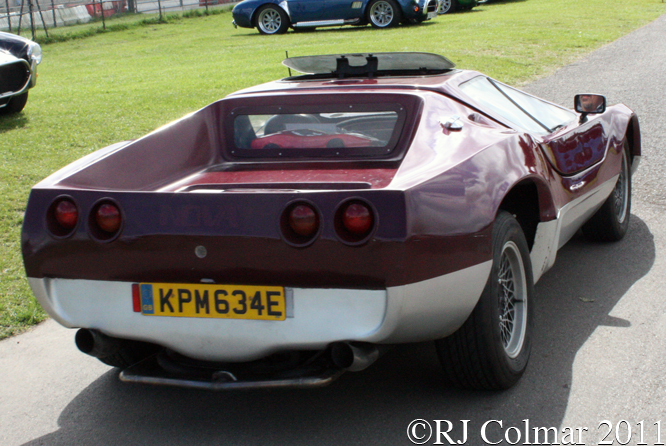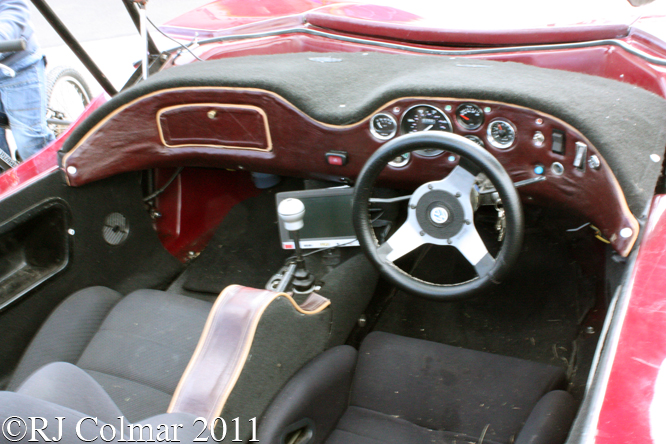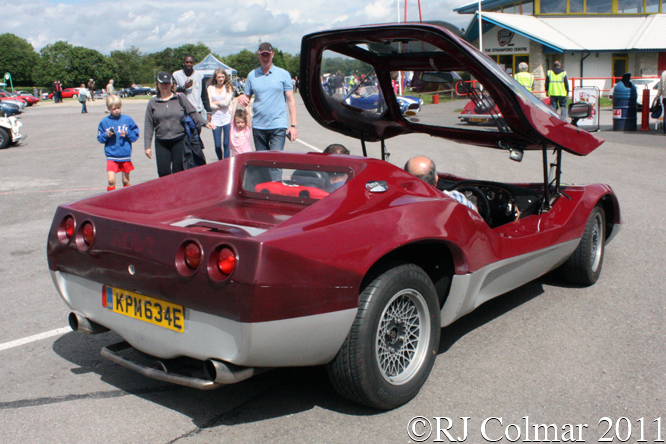For Ferrari Friday I hope readers of my Indianapolis series will forgive me getting a little out of sequence by a year or two in order to present the 1952 Grant Piston Ring Special, a Ferrari 375 captured in these photographs by my Nostalgia Forum acquaintance B² from Indiana who saw this vehicle in a Holiday Inn car park Dearborn, MI around 1971.
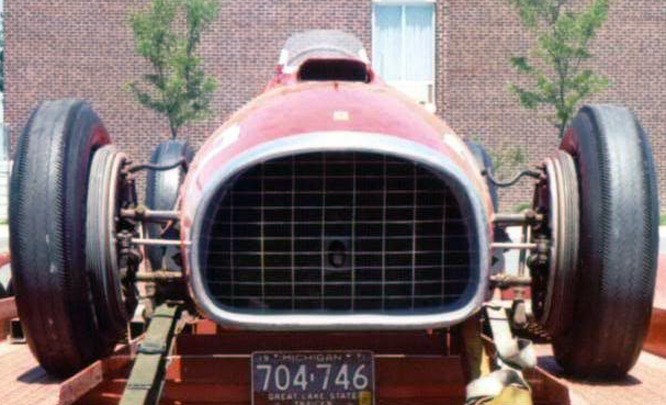
The Ferrari 375 was originally conceived as a Formula One car to take advantage of the normally aspirated engine regulations that allowed for engines up to 4.5 litres / 274.6 cui as opposed to the maximum 1.5 litres /91.5 cui maximum capacity allowed for supercharged engines.
The 375 evolved through three stages, the first stage was the 275 which featured a new Lampredi designed 3322cc / 202 cui V12 which made its debut in Jume 1950, in July 1950 the 340 made its debut with a longer wheel base de Dion rear suspension and a 4101cc / 240 cui version of the Lambredi V12.
Finally in September 1950 the 375 with a 335 hp 4493 cc / 274 cui made its debut at Monza, by 1951 Jose Froilan Gonzalez driving a 375 scored Ferrari’s first formula one Grand Prix victory in Britain to begin cementing Ferrari’s place in the top echelon of motor racing.
There were so few contenders in races run to formula one regulations that in 1952 and 1953 the World Drivers Championship was run to Formula 2, 2 litre / 122 cui regulations both won by Alberto Ascari driving a nine race winning streak for Ferrari, making the 375 essentially obsolete. When the World Championship returned to a championship for drivers of formula one regulations the maximum mandated 2.5 litre 152 cui normally aspirated engines and the large Lamperdi V12’s were consigned to being
used in sports cars only.
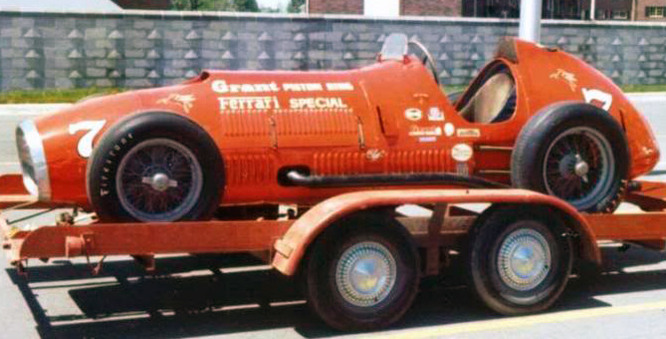
With the Ferrari 375 being obsolete in the top echelon of European racing allegedly US importer Luigi Chinetti convinced Enzo Ferrari to develop the car further with a stronger longer chassis.
Ferrari was represented at the 1952 ‘Indy 500’ by four cars 1 works and 3 customers, No: 1 ‘Ferrari Special’ for his works driver Alberto Ascari, No: 2 Grant Piston Ring Special for drivers Jonnie Parsons and Danny Oakes, No: 3 ‘Kennedy Tank Special’ for driver Johnny Mauro, and No: 4 ‘Mobil Special’ for driver Bobby Ball.
Outwardly the Ferraris appearance at Indianapolis in 1952 showed Ferrari lacking finesse preparing their cars for oval racing and that the ‘Yanks’ had little idea of how to coax the most out of what was essentially a beefed up road course car at Indianapolis.
However in his description of the 1952 race (scroll half way down), fuel injection manufacturer Stuart Hilborn shows that at the very least Ferraris disdain of many things American and his legendary machiavellian gamesmanship had come into play.
In brief Hilborn discovered that the #38 Mobil Specials cylinder head fuel inlet ports had been tampered with resulting in the ports being undersize, thus reducing the power output and it was found that the power output had been further reduced by Ferrari not fitting the high compression pistons which had been specified by Hilborn during a meeting at the Ferrari factory and presumably paid for owner Howard Keck ! (Note only one Ferrari qualified for the 1952 race not two as Hilborn asserts.)
The four 375’s were around 200 lbs over weight in part due to the drum brakes being too large and more suited to road course racing.
Despite these problems Ascari drove some of the smoothest and most consistent qualifying laps ever seen at Indianapolis, which unusually possibly due to incorrect gearing, included changing down a gear for both the first and third corners to secure 19th place on the grid.
Parsons in the second 375, even after trying magnesium wheels, opted for a more powerful Offy powered vehicle and well known midget racer Danny Oakes also failed to qualify the Grant Piston Ring Special.
Mauro allegedly really only wanted his 375 for the Pikes Peak hill climb and did not take the ‘500’ seriously and never got near a qualifying time, his car today resides in the IMS Hall of Fame now painted red.
Bobby Ball like Parsons also opted for an Offy powered machine after he had tried the forth car with Hilbourn fuel injection in place of the usual Weber carburetion. This car was restored in the 80’s destroying it’s original patina and is now thought to be in the care of a New York collector.
Ascari fancied his chances in the race switching, pre race, from a one stop strategy to a three stop strategy to accommodate higher than expected tyre wear. During the race Ascari planned to keep the revs low for the first two segments in order to benefit from the tendency of his US competitors ‘win or bust’ strategies.
Due to his weight handicap Ascari got a slow start but rose from 21st to 7th when on lap 41 the right rear wire wheel collapsed causing his instant retirement. Ascari is generally acknowledged to have given a good account of himself with a possible race contending performance up to the point of his retirement.
The No: 1 375 appeared at the 1953 ‘500’ with a 3 litre 183 cui engine, new body and side tanks but was withdrawn from the race. In 1954 it appeared again with original body and 4.5 litre 274 cui engine but failed to qualify. Ascaris 375 is currently thought to reside in Hong Kong.
Which brings us back to the car in the photograph which is thought to be the No.2 Grant Piston Ring Special unsuccessfully qualified by Parsons and Oakes,
This car was seen around 1970 on former owner Lindley Bothwell’s estate in 1970. By 1998 this 375 belonged to a Brazilian Carlos Monteverde who allowed Ludovic Lindsey to demonstrate it at Imola in Italy. During the demonstration the car suffered heavy broadside impact with a track side wall which wrote off two Borani wheels, smashed the respective brake drums, and destroyed the differential casing.
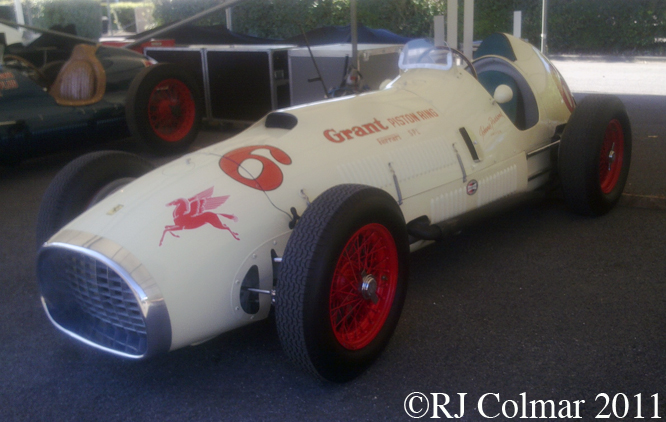
In August 2000 the No.2 375 now repaired was purchased by a Dutch owner and has been displayed in it’s white 1952 #6 Grant Piston Ring livery in the Netherlands at the Louwiman Museum and at festivals, above at Goodwood Festival of Speed in 2006, ever since.
My thanks to B² for todays photographs, and to everyone on the Ferrari 375 Indycar thread at Ferrari Chat for additional information.
There is some mystery alluding to the chameleon nature of the paint work of the Grant King Piston Ring website shows period photo’s of this car in white with cockpit wrap around screen with Johnny Parsons at the wheel and also a photo of Danny Oakes at the wheel of a red car with small screen,
if you know the correct sequence of colours and dates this car has appeared in, when it left the factory, ran in the hands of Parsons and Oakes and when it was returned to it’s current livery please do not hesitate to chime in below.
Hope you have enjoyed Ferrari Friday Indy Special edition of Gettin’ a lil’ psycho on tyres’ and that you’ll join me again tomorrow. Don’t forget to come back now !
